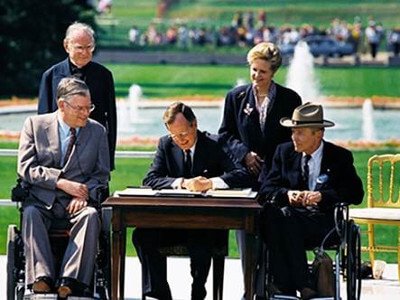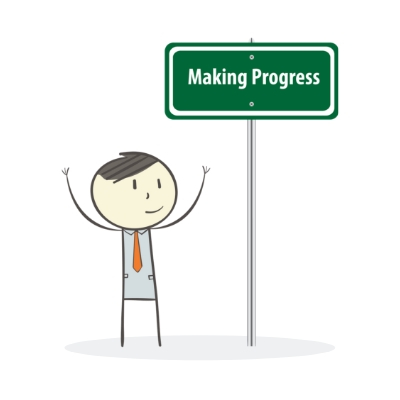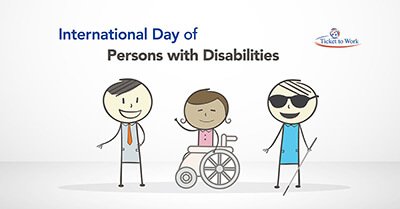 "Let the shameful wall of exclusion finally come tumbling down."
"Let the shameful wall of exclusion finally come tumbling down."
These are the words spoken by President Bush on July 26, 1990, when he signed into law the Americans with Disabilities Act (ADA).
In the nearly 30 years since that law was passed, the lives of millions of Americans with disabilities have been changed. The ADA prohibits discrimination against individuals with disabilities in all areas of public life — including jobs, schools, transportation and all public or private places that are open to the general public; and it's viewed by many as President Bush's most enduring legacy.
For the president, the declaration of equality for people with disabilities was more than good politics; it was personal. He had lost a child to leukemia and had another child with a learning disability. He had also heard the voices of thousands of people — parents of children with disabilities, advocates, legislators and academics — who expressed the need for equal treatment.
"Together, we must remove the physical barriers we have created and the social barriers that we have accepted. For ours will never be a truly prosperous nation until all within it prosper."
Because of the ADA, our physical environment is changed significantly from that of 1990 and before. We have ramps, curb cuts, more accessible parking, elevators at train stations, accessible bathroom stalls, and wider entrances and hallways.
But it's not just people who have mobility-related disabilities that must be accommodated; it's also people who are deaf or hard of hearing, people who are blind, and people who have cognitive or intellectual disabilities. So, we also have experienced changes that may be less obvious, such as job accommodations in hiring and employment, closed captioning, specialized equipment, interpreters and accessible technology.
Some of you may remember that, at age 90, President Bush jumped out of an airplane to show how fit he was. But you may also remember that when he came back to earth in front of the cameras, he returned to his wheelchair. One story has it that as his staff rolled him up and down sidewalks and ramps, the president joked: "Those ramps and those sidewalks [curb cuts] are very convenient. Who thought of putting those there?" His signature did it.
About Ticket to Work
This Presidents Day, Social Security's Ticket to Work team recognizes the contributions of President George H.W. Bush and many others to the Americans with Disabilities Act.
Social Security's Ticket to Work (Ticket) program supports career development for people ages 18 through 64 who receive Social Security disability benefits (SSI or SSDI) and want to work. The Ticket program is free and voluntary. It helps people with disabilities move toward financial independence and connects them with the services and support they need to succeed in the workforce.
Learn more
To learn more about the Ticket program, call the Ticket to Work Help Line at 1-866-968-7842 or 1-866-833-2967 (TTY) Monday through Friday, 8 a.m. to 8 p.m. ET. Ask a representative to send you a list of service providers or find providers on your own with the Ticket program Find Help tool.
 If you're working with a Social Security Ticket to Work service provider as you pursue work, you may have heard of Trial Work Period, Trial Work Period amounts, and Substantial Gainful Activity. Today, we take a look at these 3 topics and share the latest updates to them.
If you're working with a Social Security Ticket to Work service provider as you pursue work, you may have heard of Trial Work Period, Trial Work Period amounts, and Substantial Gainful Activity. Today, we take a look at these 3 topics and share the latest updates to them. The Ticket program shares information about Work Incentives and employment resources for people with disabilities on a regular basis. Subscribe to our emails and follow us on social media to stay up to date on the program and discover resources designed to help you on the path to work.
The Ticket program shares information about Work Incentives and employment resources for people with disabilities on a regular basis. Subscribe to our emails and follow us on social media to stay up to date on the program and discover resources designed to help you on the path to work. Social Security's
Social Security's  Career fairs are an excellent way to start or advance your job search. They give you the chance to meet potential employers and learn about different job opportunities. The career fairs listed in this post are just a few of the offerings in February. Visit the organizers' websites for a full list of career fairs to see if there's one near you.
Career fairs are an excellent way to start or advance your job search. They give you the chance to meet potential employers and learn about different job opportunities. The career fairs listed in this post are just a few of the offerings in February. Visit the organizers' websites for a full list of career fairs to see if there's one near you. MYTH: "If I go to work, I will automatically lose my Medicare."
MYTH: "If I go to work, I will automatically lose my Medicare." Welcome to 2019! People typically make resolutions and set goals at the beginning of a new year. But, how many of us know how to set achievable goals that are also truly meaningful to our personal and professional lives? Below, we mention a few ways to approach goal setting. However, no matter which way you choose, working with a Ticket to Work (Ticket) program service provider can help.
Welcome to 2019! People typically make resolutions and set goals at the beginning of a new year. But, how many of us know how to set achievable goals that are also truly meaningful to our personal and professional lives? Below, we mention a few ways to approach goal setting. However, no matter which way you choose, working with a Ticket to Work (Ticket) program service provider can help. In the past, we've written about the
In the past, we've written about the  To help people who receive benefits and payments keep up with the changing cost of living, Social Security beneficiaries often receive an annual cost-of-living adjustment (COLA). Each year Social Security bases the COLA on changes in the Consumer Price Index.
To help people who receive benefits and payments keep up with the changing cost of living, Social Security beneficiaries often receive an annual cost-of-living adjustment (COLA). Each year Social Security bases the COLA on changes in the Consumer Price Index. The United Nations' International Day of Persons with Disabilities on December 3 recognized the value of inclusion and equality in every aspect of a person's life. This year's theme was Empowering Persons with Disabilities and Ensuring Inclusiveness and Equality. In recognition of this global observance, meet 3 people who found the support they needed through Social Security's Ticket to Work (Ticket) program and became empowered to make choices about work that have changed their personal and professional lives.
The United Nations' International Day of Persons with Disabilities on December 3 recognized the value of inclusion and equality in every aspect of a person's life. This year's theme was Empowering Persons with Disabilities and Ensuring Inclusiveness and Equality. In recognition of this global observance, meet 3 people who found the support they needed through Social Security's Ticket to Work (Ticket) program and became empowered to make choices about work that have changed their personal and professional lives. Amy
Amy For
For  A dream job. A home of his own. Financial independence.
A dream job. A home of his own. Financial independence.